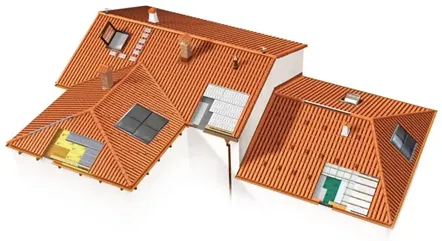Our country pages
Africa
Europe
Search
Roof structure

Why it’s important to know your roof structure
If you have ever needed to rework a roof, you have certainly encountered the terms roof structure and roof layers. All construction and renovation work requires knowledge of basic terms, since a number of subsequent decisions depend on the roof structure, including those concerning the choice of covering. Of course, you don't need to know the specialised language used by experts, but given the basic information, you will be able to:
- better understand and evaluate the proposal that the specialist will prepare,
- evaluate alternative offers,
- with greater awareness, choose the final solution that best suits your needs.
What should characterise a modern roof?
Modern homes, in terms of their visual appearance, represent a return to geometric simplicity. Such buildings are often constructed on a rectangular plan, using a simple layout that allows for efficient use of space, while being economically sound. Incorporating principles of symmetry in the building's design also helps achieve a highly aesthetic visual effect.
The roofs of modern buildings are often topped with a gabled roof. This type of roof has two large sloping sides that meet at the ridge. This geometric form fully exposes the roof from a view at ground level around the building. The best roofing material for modern buildings is, for example, flat tiles. This type of finish ensures the full functionality of the roof while also achieving an aesthetic effect. This should be taken into consideration when planning a roof renovation.
Construction and materials
A modern roof consists of many interacting roof layers, which include:
- roofing, i.e. tile or asphalt roofing, but also slabs, stone, wood or asphalt shingles. Each type of covering involves a different mounting system;
- the mounting system is another element that affects the roof structure;
- the type of insulation, or materials, synthetic (polystyrene, polyurethane, etc.) or natural (wood fiber, mineral wool, etc.);
- waterproofing systems: membranes with different technical parameters;
- ventilation: a layer of air entering under the eaves and exiting from the ridge.
1. Roofing - outer layer
Roofing, the outer layer of the roof layers, is exposed to the weather. Coverings can be made of both natural and synthetic materials that differ in many characteristics. The outer layer is designed to protect the roof and the entire building from changing weather conditions, while at the same time affecting the aesthetics.
2. Anchors - fixing system
Only the perfect fixing of the roof can ensure the stability of the entire structure of a roof. Anchors are used to fasten the roof components to the masonry. The masonry (floor purlin) is a wooden roof beam laid parallel to the wall of the building. The function of the masonry is to connect the roof to the walls of the building and to transfer loads from the roof truss to the walls. The dimensions of the masonry are standardized - this element has a square cross-section, and its side usually measures 10-15 cm. The masonry is attached to the ceiling rim with concrete anchors with threaded ends.
3. Roof insulation layer
Remember that the entire insulation layer consists of a primary layer (prevents moisture from entering from the outside), thermal insulation (insulates against heat and cold, is also an acoustic insulator), and a vapor barrier (blocks moisture from inside the house). When it comes to thermal insulation, the most common materials of choice are mineral wool, polyurethane foam, and polystyrene foam. With large slants, it is recommended to use the materials between the rafters.
4. Roof waterproofing systems
To protect the roof and the entire building from the damaging effects of rainwater, a protective waterproofing layer is laid under the roofing. Traditionally, this can be roofing paper laid on the boarding, but it is increasingly being replaced by special roofing membranes.
5. Ventilation
An expansion gap, or narrow ventilation space, is needed with both tar paper and membrane. Such a gap is formed by laying battens and counter-battens and allows water vapor to be removed to the outside.
Attic - consequences of inadequate construction
The most common consequence of inadequate roof construction or the selection of inappropriate materials is a lack of suitable thermal insulation. What does this mean? In winter, heat escapes from the building, and the temperature in the attic drops and is difficult to maintain at an optimal level. In summer, on the other hand, the air inside the attic heats up to such an extent that we are unable to stay indoors.
Beginning at the design stage, every homeowner must be aware that the roof, together with the walls, must:
- provide thermal comfort and protect residents from changing weather conditions;
- protect against cold and heat loss in winter;
- keep excess heat away from living spaces when outdoor temperatures rise;
- prevent high bills for heating or cooling (use of air conditioners);
- limit harmful effects on the environment.
Who to contact to make sure your roof meets all key specifications?
Your trusted expert will be instrumental in determining the optimal roof design. They will be able to recommend solutions that not only suit your taste, but also meet any local legal requirements. When developing recommendations, they will take into account the prevailing climate in the region and the so-called seismic conditions and verify the operation of the entire system, select the appropriate materials, and then supervise the installation of all systems.
Find a BMI-certified company
Additional information
Submit us your articles
Have you noticed that some of the articles from your country have above average results?
Those articles could be included in this repository project and be useful for your colleagues from other countries, in order to boost their SEO results!
Click on the button and find out how 👇🏻

Can't find what you are looking for? Let us know!
Are you looking for localized content aimed at the B2B market?
Can't find the specific topic you were looking for?
Interested in languages that are not included in our Repository?
Tell us your request and we'll make sure to include the materials you need!

Look for the article you need
This localized article is not the one you need?
Go to the list of articles of our Content Repository and look for a piece that is more tailored to the specific needs of your country 👇🏻
